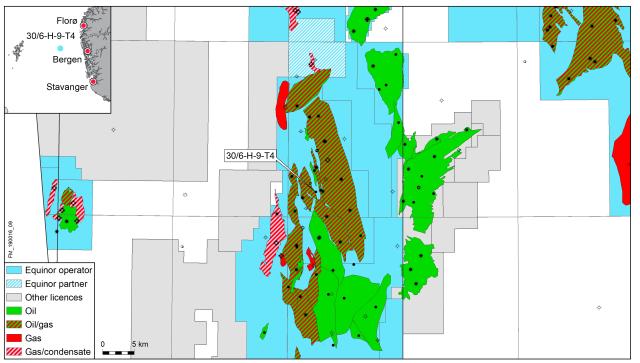
Discoveries like the one made through the drilling of the 30/6-H-9-T4 exploration well underscore the importance of near-field exploration. (Source: Equinor)
While bigger is always perceived to be better on the road to firsts, there are times when smaller is the best fit. With a suite of oil and gas giants in its portfolio, Equinor brought its smallest and most revolutionary platform onstream in 2018. In July of this year, the company announced the discovery of a 112-m (367-ft) oil column in a segment of its Oseberg Vestflanken Field that had not been previously tested. The well will be put onstream soon via the Norwegian Continental Shelf’s (NCS) first unmanned, remotely operated H platform on the Oseberg Field, a news release stated.
“This discovery improves the Oseberg Vestflanken resource base. It can be put onstream with limited investments and adds significant value to the partnership. We are combining drilling of exploration and production wells to achieve highly profitable exploration wells at low cost,” said Gunnar Nakken, senior vice president for the operations west cluster of Equinor, in the release. “Discoveries as these underline the importance of near-field exploration. Our ambition is to maintain profitable production from the NCS for several decades. A major contribution will come from wells that are drilled at low cost and close to existing infrastructure.”
The 30/6-H-9-T4 exploration extension well was drilled by the Askepott jackup rig as part of the Oseberg Vestflanken 2 project, the release stated. Plans call for the drilling of 11 wells total by the Askepott, with nine being drilled through the platform and two through an existing subsea template.
The Askepott is a GustoMSC CJ70 rig model specifically designed for year-round use in moderate and harsh environments in water depths up to 150 m (492 ft) on the NCS.
The road to the Oseberg H platform started out as a project in 2012 to find a simpler, more cost-effective solution to deliver NCS hydrocarbon resources from below the seafloor to the shore. So Equinor set about delivering a solution dubbed “subsea on a stick” that eventually found a home at Oseberg Vestflanken.
If there were a Hall of Petroleum Giants, then the NCS would have long ago snagged a seat at the hall’s table as it is home to Ekofisk, Statfjord, Oseberg and Snorre, all discovered prior to 1980.
The Equinor team looked to tap into the extensive infrastructure of these aging giants. The Oseberg H platform is fully automatic and remotely operated. There are no living quarters, helicopter decks, lifeboats or toilets on the platform. Operations are tied back to the Oseberg Field Center located 8 km (5 miles) northwest of the platform.
“Oseberg H is a pilot and our first unmanned platform,” said Anders Opedal, Equinor’s executive vice president for technology, projects and drilling, in the release. “We are further developing the concept and believe that the next version will be even more competitive.”
Recommended Reading
Beyond Energy: EnergyNet Expands Marketplace For Land, Real Assets
2024-09-03 - A pioneer in facilitating online oil and gas A&D transactions, EnergyNet is expanding its reach into surface land, renewables and other asset classes.
Diversified Energy Closes on 170,000-acre Deal in East Texas
2024-08-16 - Diversified will pay $106 million for the natural gas assets through the issuance of 2.24 million new shares and $71 million cash.
For Sale: Grandma’s Minerals
2024-08-16 - A younger generation more open to selling subsurface rights has increased supply for the minerals and royalties market, and Mesa Minerals III is buying up interests in the Permian and Haynesville.
Marketed: South Texas Assets in McMullen, Zapata Counties
2024-08-15 - The Trustee of El Dorado Gas & Oil and Hugoton Operating LLC has retained Energy Advisors Group for the sale of South Texas assets in the A.W.P (Olmos) field in McMullen County and in the Mecom Ranch lease (Lobo) in Zapata County, through a bankruptcy sale.
Strategic Minerals Buying: A Complex Game of 52 Card Pickup
2024-08-09 - Enverus’ minerals expert Phil Dunning pulls back the curtain on generational changes and seismic shifts in the U.S. minerals market that make it challenging to for aggregators to achieve scale.
Comments
Add new comment
This conversation is moderated according to Hart Energy community rules. Please read the rules before joining the discussion. If you’re experiencing any technical problems, please contact our customer care team.




